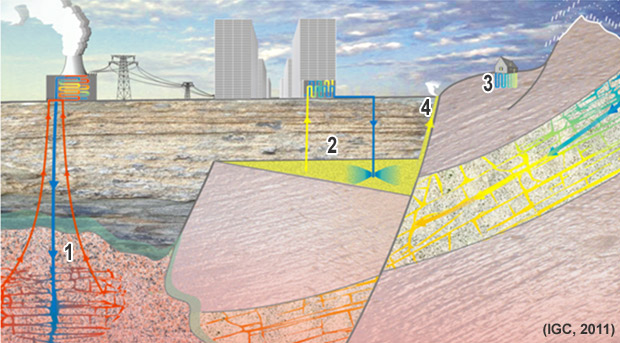A geothermal reservoir is a volume of rocks in the subsurface which exploitation in terms of heat can be economically profitable.
It should be noted that for producing the heat from the subsurface is necessary the presence of a transport fluid (usually water), and that drilling to an enough depth to reach the optimum operation temperatures is also necessary. These factors and the technical and other concerns entail costs which increase with depth.
The temperature of the fluid and the possible applications are important to sort reservoirs. Thus, four types of geothermal reservoirs can be defined:
High temperature: These reservoirs provide enough heat to make electricity from steam profitably. High temperature reservoirs are generally more than 150° C, and are located in areas of thin lithospheric thinness or active volcanism.
Within the group of high-temperature geothermal reservoirs there are "Hot Dry Rock" (HDR) geothermal reservoirs, which are exploited by the techniques called "stimulation of geothermal reservoirs" (EGS: Enhanced Geothermal System). They consist of fracturing a mass of deep rock to create a geothermal reservoir allowing the circulation of fluids inside it. These reservoirs not require high thermal gradients, but a very specific geological context. Although the implementation of such reservoir is still experimental (i.e. Soultz-sous-Fôrets, in France) in Catalonia have been granted some exploration permits.
Middle temperature: Despite these reservoirs have a lower temperature compared to the high temperature ones, they allow extracting sufficient heat to produce electricity (but with lower performances) using a volatile fluid. The reservoirs usually reach temperatures between 100 and 150º C, and are located in areas with favourable structural and geological contexts and geothermal gradients higher than the average. Their direct use may be in heating mode and their main applications are in district heating systems and industrial processes.
Low temperature: The temperature of these reservoirs is between 100 and 30° C. They are located in areas with a favourable geological context including deep aquifers; the geothermal gradient is like the average in the region. Their exploitation involves pumping hot groundwater from the aquifer and re-injecting it after it has delivered the heat and is cold again. These are used in direct applications and for district heating systems and industrial processes.
Very low temperature: The temperature of these reservoirs is below 30° C. In these, the underground is used as a heat exchanger, by means of a heat pump in a closed circuit. Their applications are in domestic and agricultural air conditioning systems. These kinds of reservoirs may be anywhere, because their efficiency is just determined by the underground thermal inertia in normal (average) geothermal gradient conditions.
Examples of different types of geothermal reservoirs exploitation:
1) High temperature: In a deep granitic basement beneath a sedimentary cover (ratio units with a thermal conductivity contrast promotes the geothermal gradient), cold water is injected and hot water is extracted in such a way that in contact with a second surface circuit, it generates hot steam for electricity production.
2) Middle temperature: Hot groundwater is drawn from a deep aquifer to exchange heat within an urban district heating system, and cold water is re-injected.
3) Very low temperature: Ground thermal inertia is exploited through a buried heat exchanger that provides a stable fluid temperature to heat a house in winter and cold it in summer.
4) Thermal spring: It is also represented on the picture a natural thermal convection half-cell caused by a groundwater circulation process: Infiltration in a recharge zone, a slow transition through a deep aquifer, quickly draining to the surface through a permeable fault giving way to a thermal spring.

 Contact
Contact








